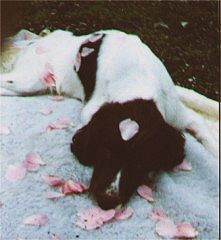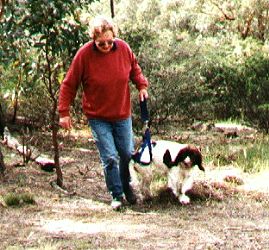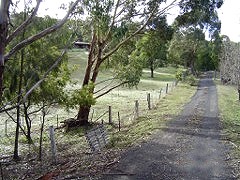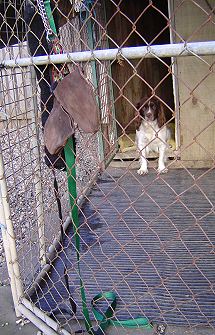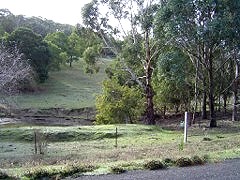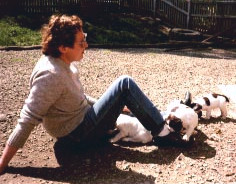  Wrangham Shawnee was born on Mothers Day of 2001. One of a litter of six, her dam, Blossom, was from (imported) UK field trial lines. Her sire,
Wrangham Purple Emperor, was the son of RTCh Wrangham Mountain Ash UD, AD, and FTCh Marny of Sirah-Selah DM - two top performers on the Australian Field and Retrieving Trial scene.
At eight weeks, I sent Shawnee to a neighbour, Margaret, for “puppy walking” and she was named Petals after her mother, Blossom.
It was soon obvious that although her social training went well, her desire to hunt overrode all other drives and she returned to me earlier than planned to begin her yard training. She was an energetic and adventurous puppy with a burning desire for action. She was fascinated by the moths and butterflies and, to put it mildly, she was a monster to have in the yard. Several times I nearly sold her but pulled out at the last minute. One day a friend, Steve, who had watched me struggling with her suggested that he would take her for awhile on condition that he could change her name. She went to his kennel and became "Win". Her great nose and tremendous drive marked her out as potentially one of the great bitches of her generation. She was a lovely type of spaniel - strong in body with excellent temperament both in the field and socially.
Because Steve was going away for two months in September 2002, we sent her to another colleague, Marko, to gain some experience. She was 15˝ months old, and a good prospect for trialling in winter 2003 - some ten months away. Marko is a breeder of pheasants and of the Brittany. He has access not only to pheasants, but also to some rabbits (at that time, rabbits were scarce in Victoria). Needless to say, she got on well with Marko, his family, and delighted him with her intelligence, natural ability and eagerness to get on with the job. Her education was going well.
The call came on a Saturday night in late September. Marko had been out with another friend and his spaniel, Ben. They had been ferreting on a local property. They were training the dogs to sit by the burrows and watch the rabbits bolt then retrieve, later. The next day, both dogs were sick. Ben was so ill that he was on a drip at the Bendigo Veterinary Hospital, and Win with very swollen glands was on antibiotics. By Tuesday there was no improvement. Ben was still on the drip and all tests had proved negative. Win had become much worse and Marko’s visiting country vet was mystified, so I decided that she should come back home to my own vet in Bacchus Marsh. The next day, I set off early and drove the 145 kilometers to get her. It was a beautiful spring day. I remember the warmth of the sunshine as I travelled north and that feeling that all was well with the world. However, I came down to earth with a crash when I saw Win. The once vibrant spaniel could only just stand, her neck was swollen and although her eyes were bright, she could only just manage to wag her tail.
"I had nightmares about what had made the dogs so ill. They had been hunting in an old gold mining area... had they been poisoned?"
I think that I broke the speed limit in my 150 kilometer dash back to Bacchus Marsh. I had phoned the vet and they were expecting me. We had to lift her from the car as she was limp, like a wet rag. Packed in ice and on a drip, she looked pathetic. Her temperature was 41.5C and she was in “melt down”. Urgent blood tests were taken and sent away for analysis – all came back negative. In fact, all they could tell us was that she had an elevated white cell count suggesting a massive infection of some sort.
The days dragged on. Ben was improving slightly but we were still no further towards discovering the cause of their illness. Test, test, test. I was determined to find out what had caused this massive reaction. Next time, it could be someone else’s dog. We spoke about her prognosis. It was not encouraging. I insisted that they do more tests and consult more specialists locally and overseas. She had become my little Petals again. I had nightmares about what had made the dogs so ill. They had been hunting in an old gold mining area... had they been poisoned? The old timers were known to have used arsenic and other heavy metals in their attempts to separate out the gold. There are still contaminated pools and slag heaps everywhere.
Still Petals hung in. It seemed that the only bits of her that were alive were her eyes which followed every move.
Days passed... still testing. Biopsies, more blood... day in, day out... consultants from all over the world offering advice. Still, no result. Bacteria? Virus? Heavy metals? Fungus? Micro-organisms? Agri-chemicals? Poison?
A week had passed. Her temperature had stabilised and she was off the drip for most of the time. She was getting stronger. Petals could lift her head and was trying to push herself up on her front legs. But, from the waist downwards... nothing. No reflexes, no feeling, nothing. The vet reported that, during the long night shift, she had been reading to her about her possible diagnosis and Petals had been listening with interest!
Ten days later, still testing with no result, the vet said, “I think you should take her home. She can propel herself forward like a wheelbarrow if you put a sling (towel) under her tummy.”
Seventeen months old and bred to work, Petals was like a piece of rag but still she looked at me with that, “Come on, lets get going. What are we waiting for?” look.
We discussed her future. “Will she improve?” I asked.
“She will make a lovely pet” was the vet’s reply.
What to do? I know she will never make a pet. She is too action driven.
Margaret, the neighbour who had her as a puppy, made the decision for me by offering to take her for awhile, so we set up her family room as a convalescent area with mats, cushions etc and a small outside pen where she could lie in the sun. Margaret was wonderful, challenging her to do more for herself, keeping her clean, moving her limbs and massaging her non existent muscles. My contribution at this time was to go up two or three times a day to walk her in the bush garden in a sling and collect and do the mountains of washing.
Then progress – she started to wag her tail – not much, but it was something. Anxious to get on the move, she had also started to drag herself along with her front legs. Ofcourse, this meant that she was rubbing her knees and feet along the carpet or ground so we put her in socks and ordered leather boots. On one afternoon, she even dragged herself off after a white butterfly and, to our amazement, actually got up on to her back legs for a second as she watched it fly away.
By now she was too heavy and active to hold in a towel, so I “invented” a harness for her waist. It was also difficult to hold her in the towel sling as she insisted on hunting every bush that we passed. I was given a walking frame with wheels for her by the Veterinary School at Melbourne University but, after some hair-raising moments and a couple of crashes, I sent it back. It was not designed for active young gundogs like Petals!
Because she had this burning desire for activity, I decided to take her to the dog center for swimming. This center is about a hour drive from my house and the pool is specially designed for dogs to exercise in. Buoyed up by the water and the floatation straps we put on her, I walked round and round the pool with her in the water, encouraging her as though I was coaching a top swimmer. She started to move her back legs. I was elated. Out of the water, her back end was like jelly. I was depressed!
On November 17th - seven weeks after she was taken ill - she came home. Now she could crawl quite fast and was trying to move her back legs when I held her weight in the harness. However, her back legs were still like rags, not under control at all and she had a marked adductor gait crossing her back legs as she “walked”. She could not feel her feet and trailed them along, although she could stand momentarily if I placed her feet correctly.
Because I was concerned about her pressure sores, I decided to house her in the dog trailer which I lined with sheepskins from our local shop.
I live on a four acre block divided into two paddocks. The house sits high on the block and the ground slopes steeply down to the road. At the lowest point in each paddock there is a dam. About ten or twelve times a day, I got her out of the trailer and walked her across one or other of the paddocks, trying hard to contour round the hillside as I did not want us both to finish up in the dam and have to climb the 200 meters back up the hill to the house.
Slowly, Petals was beginning to take her weight on all her legs and move her back legs more purposefully. She was also gaining better control of her bladder and bowel, and I discovered that she was regaining her voice. I had not even noticed that she had lost her voice but in retrospect I noted that she had been silent since being taken ill. She could now tell me when she needed to get out but I had to be quick as she could not hold on for any length of time.
Again I talked to the vets about her future. They told me that she had Idiopathic Polyradiculoneuritis known as Coon Hound Paralysis in the USA, but we have no raccoons in Australia. This meant that for some reason, as yet unknown, the myelin sheath round the nerve fibres had been destroyed. However, they assured me that remyelination would occur and she would improve. Friends who have experience with human patients with Guillain-Barre Syndrome (GBS), a similar condition, tried to cheer me up telling me that she was making good progress and that remyelination of the nerves is extremely slow - just millimeters a month - but that she would get better if I stuck with it. Other friends just shook their heads, looked at me sideways and asked me what I intended to do with her. The vet still insisted that “she is so lovely, she will make someone a great pet”!
At about Christmas, I gave up taking her swimming. By now, Petals was able to swim strongly almost without assistance for in excess of a kilometer, and could launch herself into the water from the middle step and almost pull herself out of the pool. From here on, swimming would be in the dam. I bought some rubber stable matting and made a run out of concrete pavers covered with this matting so that I could move her out of the trailer. The sleeping quarters, a little cubby house, were still lined with sheepskin and the leather boots, harness, etc... were hung ready on the door. Petals’ home was now “At the Sign of the Crossed Boots”.
Then, in an apparently separate incident, we had a big hatch of lovely brown and orange butterflies and the chase was on! Petals charged round the paddock in her harness with me attached to the other end of the lead, in hot pursuit. I tried to make her walk correctly, use her feet, etc... but just as I got her to concentrate, another butterfly would attract her attention and we were off again. I cursed the butterflies that flew downhill taking us both with them only to disappear at the bottom so that we had to climb back up again. It was January and three months since the infection. I was exhausted, but still we plied up and down the hill. Friends told me that it was time that I gave up the unequal struggle as Petals looked no better, but I, pigheadedly, refused to give in as I knew from the pull on the end of the lead and harness that she was getting stronger and was gaining more control over her legs. Her desire to hunt and her refusal to give up spurred me on. I made a wager with one of my friends that Petals would walk one kilometer (albeit with the aid of her harness) on the day of the “Thousand Paws Walk” which was at the beginning of March.
The Wood Ducks returned to the dam and provided yet another incentive to run down the hill! I felt that she was really making use of me as an anchor and an excuse to lift all four feet off the ground and swing across the hillside in her effort to quarter the ground. More than once I was obliged to let go of the lead and harness as I fell and rolled to a stop only to see Petals struggling to pull herself up and get on down the hill after a butterfly or duck.
Two commands dominated our outings –“stand up” and “walk properly”!
At this time, Petals was waking at about 5AM and crying to be let out (she was still unable to bark but could make a funny crying sound). I would hasten outside, put on her harness and walk her down the drive - just a short way so that she could relieve herself. That was the pattern. Then, one day in mid-February, she could not wait for me to get the harness on and, to my surprise, she did not just squat in the pen where she was, but walked past me out of the pen before falling over and squatting. I could not believe my eyes. I dared not tell anyone in case it was an aberration but she did it again the next day and by the end of the week could get from her pen and walk 10 meters or so into the yard before collapsing. Interestingly at first she would only walk on her own when it was dark and it took her several days to get the courage to try in the daylight.
"As far as Petals is concerned, anything is possible and life is to be enjoyed."
I called the friend with whom I had the bet and told her to come round but be sure that the dogs did not hear her. Then as she watched from the window, I let Petals out of her pen and, to my delight and her amazement, she walked and stumbled across the yard. She was on her feet and under her own steam at last. We did not win our bet because a couple of days before the “Thousand Paws Walk” she came into season, but my faith had been vindicated, she would have walked the distance easily.
Of course, it took a considerable time for Petals to be really independent again.
I adapted the harness so that she took her own weight. I merely did the steering for her rear end and stopped her from falling over too often. In late March, we abandoned the harness except for long walks and on 5th April she walked 100 meters down a friend’s drive, unaided. It was six months since she had been taken sick and she was one month short of her second birthday.
Improvement was now measured in how long she could manage to maintain her balance. It seemed that her front end and her back end were working independently and we had some great laughs at her expense as she ran about and could not control her momentum.
Petals has never ceased to amaze me.
One day, I was putting the dogs into their kennels and called Rev (another bitch) into her top bunk - about 60 CMS off the floor. A dog sprang passed me and I went to close the door. Imagine my surprise when there, happily looking at me, was Petals! Then, there was the day I found Petals merrily running in the paddock next door – she had climbed over the one meter fence! Yes, she can run and jump - and although she looks rather ungainly because she tries to go too fast, she is 100% capable of hunting and retrieving. She will never be the super athlete who promised so much, but she is still a determined worker and treats her handicap with disdain. As far as Petals is concerned, anything is possible and life is to be enjoyed. Of course, in our efforts to get her to move again, all training has gone by the board and she is again a loveable monster
The other day I was standing with Steve watching his dogs and Petals swimming in his dam and hunting the reeds. Even handicapped her tremendous drive and enthusiasm are obvious; she is such a happy dog and throws herself 200% into everything she does. What would she have been like if she was not handicapped? Who knows? Steve called the dogs out of the water and, on the way, Petals spied a butterfly. She was off across the paddock, running, jumping, chasing in an effort to catch it. Steve went after her, laughing as he went. I used to curse her for being so distracted by the moths and butterflies, but if it had not been for the butterflies I don’t think Petals - or should it be Win? - would be where she is today.
We are still no closer to discovering what caused the initial infection. Ben has recovered although he still shows signs of weakness in his legs. Petals is an active, although uncoordinated, spaniel with a great zest for life.
Thank God for butterflies.

|
